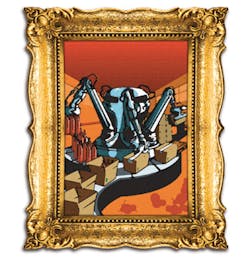But then it made me think of people losing their jobs, for whom it won’t be easy to find something new.
This reminded me of the time I myself was unemployed. I was 25 years old when I graduated as an art historian from a Dutch university, in 1993. I went to the employment agency, looking for a job. My brother had studied Chemical Process Technology, and several companies had told him that he could start working there right after he’d received his bachelor’s degree. But times had changed, and there were no vacancies for technical people anymore, let alone for art historians. The employment agency wasn’t even prepared to register me. I was too old and could only type with two fingers.
I decided to respond to announcements in the papers. Sometimes I sent five letters of application a week, which all resulted in rejections. One of them said: “We received 735 responses. We’re sorry, but you’ve not been selected.”
Gain experience
In order to increase my working experience, I started to do volunteer work for a museum, 32 hours a week. I got a little money from the Dutch government to survive, so I bought my clothes at the second-hand market and my food in the cheapest supermarkets. Three years later, I found my first paid job. I was 28. I assisted high school pupils with their English and French homework. This kind of job was actually meant for students. It paid approximately $7 per hour, and in times of holidays, I had no job, so no money.
A few years later, I applied for another function. Hiding the fact that I had a master’s degree, I got a job as a public relations assistant at the garbage collector. After that, I found a job at an SAP project; I had to write user manuals and train users.
During those days, my husband had been away from home, living in a hotel in the south of the Netherlands for more than six months already. So I decided to look for a job in that region. On the Internet, I saw a vacancy for Manager Training, at a company that had a contract with ISA to offer the ISA88 and ISA95 training courses. I had no idea what that was. I’d never even been in a factory.
“I don’t know much about computers,” I remember saying during the job interview in 2000. “I only know a bit of Word and Powerpoint.”
“That’s no problem,” the managing director said.
It took a lot of studying and coaching from colleagues before ISA accepted me as a teacher. I taught the ISA88 standard to senior engineers. To be honest, at the start, I didn’t even know what an “engineer” was.
Once, my employer said: “If I would lose my job, I would take anything, even if that meant becoming an operator on an assembly line.”
“They won’t hire you,” I told him. “You’re a 50-year-old managing director. They can easily find younger, cheaper people, who won’t leave when something better comes along!”
I’d experienced the same arrogance and naivety during the SAP project. After university, the young consultants had immediately found a well paid job, with a company car. They thought they had realized it all by themselves.
My communication and consulting skills have helped me to become successful in the world of industrial engineering, even though I’m an art historian. Last November, I got three ISA awards for my book about ISA95—a bestseller. So now, you know how a crisis can lead to success.
Bianca Scholten, [email protected], is a Principal at IT integration firm TASK24, in The Netherlands, and a voting member of the SP95 committee of the International Society for Automation. Her book, “The Road to Integration; a Guide to Applying the ISA-95 Standard in Manufacturing,” is available at www.ISA.org.
Subscribe to Automation World's RSS Feeds for Columns & Departments
About the Author

Leaders relevant to this article:
